…where east meets west
- Home
- Brief History
- The Greenwich Meridian
- Greenwich
(1675–1958) - Herstmonceux
(1948–1990) - Cambridge
(1990–1998) - Outstations (1822–1971)…
- – Chingford (1822–1924)
- – Deal
(1864–1927) - – Abinger
(1923–1957) - – Bristol & Bradford on Avon
(1939–1948) - – Bath
(1939–1949) - – Hartland
(1955–1967) - – Cape of Good Hope
(1959–1971)
- Administration…
- – Funding
- – Governance
- – Inventories
- – Pay
- – Regulations
- – Royal Warrants
- Contemporary Accounts
- People
- Publications
- Science
- Technology
- Telescopes
- Chronometers
- Clocks & Time
- Board of Longitude
- Libraries & Archives
- Visit
- Search
Astronomical Regulators: Riefler 50 and Cottingham
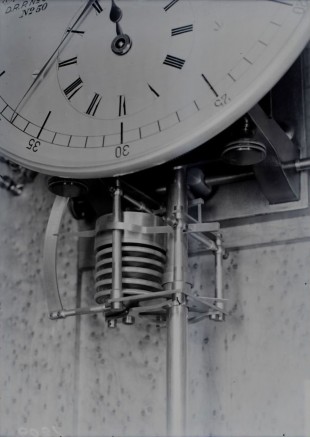
Part of the dial and the barometric compensation device of Riefler 50, 14 March 1929. Note the serial number which can be seen top left. © BT Heritage. Image Ref: TCB 417/E 6037. Reproduced under the terms of a Creative Commons Attribution-Non-Commercial-ShareAlike (CC BY-NC-SA) licence (see below)
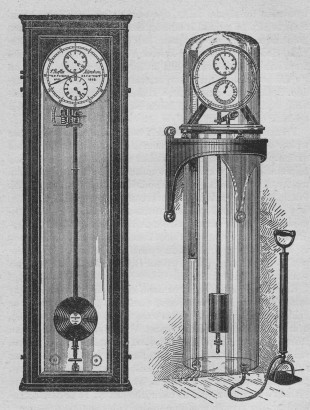
Two designs of clocks by Riefler. Riefler 50 was similar in appearance to the one on the left. The Cottingham was similar to the one on the right. Based on an earlier German advert, this image was published in Schneider's Přesnı čas (c.1925). Downloaded from Wikimedia
Preamble
Dent 1906, which incorporated innovations by Airy, became the sidereal standard of the Observatory in August 1871. By the start of the twentieth century, clocks made by the German company Clemens Riefler had set a new standard in precision timekeeping and were being adopted as primary standards in observatories around the world. Riefler Clocks came in a number of different designs of increasing accuracy (and expense). The most accurate were Types A, D & E. In the D and E, versions, the pendulum swung inside an evacuated chamber in the form of a cylinder. Both the Cape of Good Hope and the Royal Observatory Edinburgh had acquired one by 1912. For reasons that are difficult to comprehend, especially given its global reputation, it took until the early 1920s for Greenwich to begin to play catch-up.
William Christie, who had joined the Observatory as Chief Assistant in 1870, became Astronomer Royal in 1881, retiring 29 years later in 1910. During his first 15 years as Astronomer Royal, there was a massive increase in the number of large telescopes deployed. Funded in part by the taxpayer and in part from generous donations, there were seven in total: the Lassell 2-foot Reflector, the 13-inch Astrographic Refractor, the Thompson 9-inch Photographic Refractor, the 28-inch Refractor, the Thompson 26-inch Photographic Refractor, the Thompson 30-inch Photographic Reflector (1896) and Christie’s Altazimuth. By the turn of the century, Christie’s programme of expansion at Greenwich had come to an end, but without a single new clock being purchased. Nor was one acquired during the remainder of his tenure. Nor did Christie procure a replacement for the aging Airy Transit Circle, despite the fact that: a) he had put steps in place to replace Airy’s Altazimuth in 1892 and b) the copy of the Airy Transit Circle at the cape had been replaced by Gill with a reversible transit circle in 1905. The Airy Transit and Dent 1906 were a well matched pair in terms of their capabilities. The downside, was that Dent 1906 was incapable of detecting the issues with the Airy Transit that eventually lead to it being replaced by the small reversible transits for time determination in 1927.
With the new telescopes and facilities, came a significant increase in both the range and amount of work being done. Christie’s failure to secure in advance any sort of commitment from the Admiralty to increase the staffing levels combined with high turnover amongst the temporary computers, put him under considerable personal pressure which inevitably took its toll. In June 1905, he was ordered by his doctor to give up his work immediately, leave Greenwich and live in the open air, giving up his duties and responsibilities altogether (ADM190/16). The physician’s report sent to the Chairman of the Board of Visitors, Sir William Huggins, stated amongst other things that his capacity for work was small and for sustained work was nil. Christie’s symptoms suggest he was suffering from a combination of stress and heart failure. They were listed in the report as follows:
- His pulse is rapid and feeble – the heart being irritable and tending to dilate
- The blood vessels throughout the body are slightly infected and the liver is a little swollen
- The nervous system is feeble and excitable and there is a marked tendency to insomnia.
According to the Chief Assistant, Frank Dyson, the illness was a repeat of one that Christie had had a few years earlier. Reading between the lines, it seems likely that Christie was afflicted throughout his last ten years as Astronomer Royal – the very period when the Rieflers were being adopted elsewhere.
The U.S. Naval Observatory acquired a Riefler in 1904. Three years later, on 22 March 1907, William Eichelberger published a paper in which he compared its rate with that of Dent 1906 at Greenwich. Click here to read. By his analysis the mean deviation of the daily clock rate of his Riefler was 0.015 compared to 0.051 for Dent 1906. Thomas Lewis, the Head of the Time Department at Greenwich refuted this analysis in a letter published on 31 May. Click here to read. Not to be cowed, Eichelberger responded with a letter that was published on 28 June. Click here to read. What, at the very least, ought to have been a wakeup call to Greenwich to properly investigate the merits or otherwise of the Rieflers, seems, on the face of it, to have been ingnored.
Christie retired in 1910 and Lewis in 1917. Christie’s replacement was his former Chief Assistant Frank Dyson who had been appointed Astronomer Royal for Scotland in 1905. Dyson was replaced as Astronomer Royal for Scotland by Ralph Sampson. As things turned out, having re-equipped the Edinburgh Observatory with new clocks, it was Sampson, rather than Dyson who took the initiative to start a research programme looking into the determination and recording of time, a study into the behaviour of observatory clocks. Consciously or otherwise, Edinburgh stole a march on Greenwich.
When Dyson arrived back at Greenwich there were many pressing things that took a while to sort as the Observatory was in a run-down state and considerable construction work was required in Flamsteed House to make it suitable for his family to live in. The First World War had a significant impact on the efficiency of the Observatory. Most of the Computers and some Assistants were called up for war service. Some Assistants were seconded elsewhere and both Chief Assistants were absent for a while, one as a commissioned officer and the other on secondment to the Optical Branch of the Inspection Department at Woolwich Arsenal.
Meanwhile, back in May 1910, the Paris Observatory had begun broadcasting time signals from the Eifel Tower. In July 1912, Dyson installed equipment to receive them and others that were being broadcast from Norddeich. But it took until 1920 for him to take action on the clock front. What exactly prompted him to do so then is unknown, but the idea may have been seeded by the clockmaker Edwin Cottingham while he was staying with Dyson for a couple of nights in March 1919 before setting off on the 1919 eclipse expedition with Eddington. In his Report to the Board of Visitors which he completed on 22 May, Dyson wrote:
‘Much time has been spent during the last few months on the sidereal standard clock. The room in which it is mounted is dry, and a constant temperature is satisfactorily maintained. The barometric adjustment has been overhauled and appears to be working satisfactorily. But the going of the clock is not up to the standard of the best modern clocks, and it will be necessary to obtain a new one.’
He was supported in this by the Board at their meeting on 14 June when it was ‘Proposed by General Hills, seconded by Admiral Sir John Parry and carried: – That it is desirable that the Royal Observatory should possess three standard clocks in good working order.’ (ADM190/6/188)
The acquisition by the Royal Observatory of an original Type A and a copy of a Type D Riefler
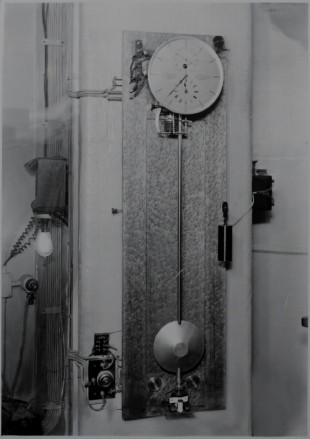
Riefler 50 in the Rugby Room, 14 March 1929. The case has been removed, presumably for the purpose of photography. The General Post Office (G.P.O) were responsible for the Rugby Transmitter, and it was they who took the photo. © BT Heritage. Image Ref: TCB 417/E 6036. Reproduced under the terms of a Creative Commons Attribution-Non-Commercial-ShareAlike (CC BY-NC-SA) licence (see below)
Riefler 50 (which was made c.1900) arrived at Greenwich on 23 June 1920, and was set up in the Clock Room at the western end of the Meridian Building on the 30 July (RGO39/10/61 and Report). The Cottingham was delivered on 25 February 1921. It too was installed in the Clock Room in the Meridian Building. It was adopted as the sidereal standard in place of Dent 1906 on 24 October 1922.
An entry in the 1911 inventory (RGO39/4) records the following information about the cost of the Cottingham:
‘In accordance with terms of contact one half
of purchase price (£112:10/-) was paid 11/3/21.
Balance of a/c forwarded to AG for payment 3/1/23
Balance of £112:10/- Extra apparatus £15 Transport £5
Total £132:10/-’
The purpose of the two clocks
Whilst the records show that the Cottingham Clock was ordered with the specific intention (subject to performance) of it replacing Dent 1906 as the sidereal standard, Dyson’s intentions regarding Riefler 50 are less clear. The inventory records contradict the photographic record. There are no mentions of the clock in the Reports of the Astronomer Royal to the Board of Visitors following the announcement of the clock’s arrival in 1920.
The three relevant inventories (1911, 1926 and 1933, (RGO39/4.5&6)) consistently list the Riefler as being in the Clock Room. However, the 1929 photos on this page show it mounted in the Rugby Room (in the eastern summerhouse).
The Riefler was overhauled by Cottingham at the end of 1920 (28/XII/1920) and again in February 1923 (RGO39/4/61). A few years later Shortt 16 was purchased to take over the role of mean solar standard and to regulate the distribution of radio time signals (the ‘six pip’ signal transmitted by the BBC and the Rugby rhythmic time signals transmitted by the Post Office) and to regulate other clocks at the Observatory. It arrived at the Observatory about a year after Shortt 11 on 26 October 1927 (RGO39/5/223), and was set up in the newly established Rugby Room on the ground floor of the of what had been Flamsteed’s eastern summerhouse. Around the same time, various alterations were made to the Riefler which was clearly intended to be part of the new installation. The 1926 inventory (RGO39/5/222) gives the following information:
1927/04/26 Magnetic control applied. Order No, 137
1927/08/27 Contact apparatus fitted to give ½ minute signals. Order No.161
1927/12/17 escapement cleaned and adjusted. Order No. 302
That it was modified to give ½ minute signals suggest that it may have been intended as a reserve for the Shortt 16 slave. If so, it would have taken over in October 1929 when the Shortt slave was overhauled (RGO39/4/224). On this evidence, it is surmised that the Riefler may have been obtained with the original intention of it becoming the mean solar clock in place of Dent 2012 which itself had replaced the Shepherd Clock when it was demoted to mean solar reserve in May 1893 (Introduction to the 1884 volume of Greenwich Observations p.xx & 1893 Report). Alternatively, the Riefler may have been obtained not as replacement for the mean solar clock, but as a replacement for the mean solar reserve (i.e., the Shepherd).
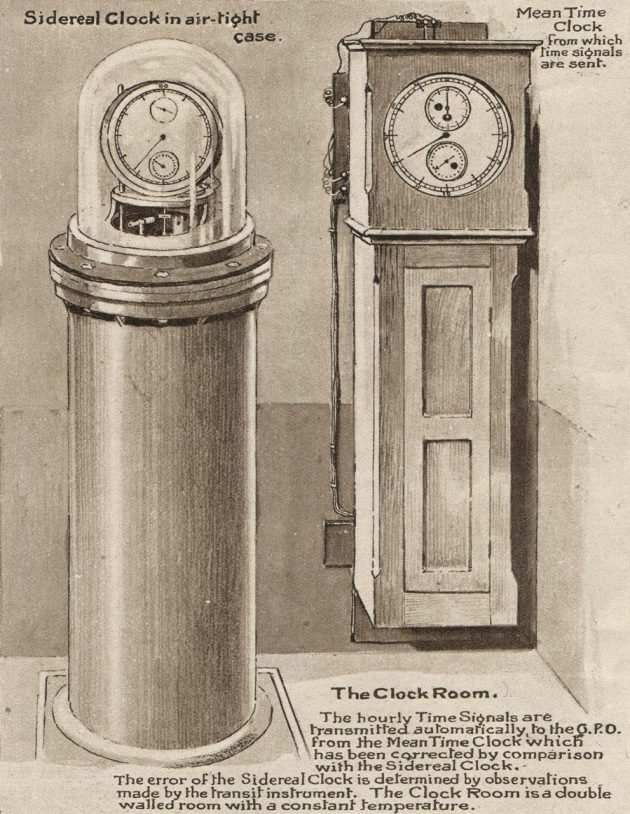
Dent 2012 right with the sidereal standard made by Cottingham to its left. In reality, the Cottingham is believed to have been wall mounted and both clocks are believed to have been housed in different positions to those shown. Drawn by W.B.Robinson, probably from photographs, the inscriptions on the two dials have been omitted. The image formed part of a double page spread of seven images published as part of an article by the Head of the Time Department, William Witchell, titled How Greenwich Time is obtained that was published by The Illustrated London News on 21 April 1923
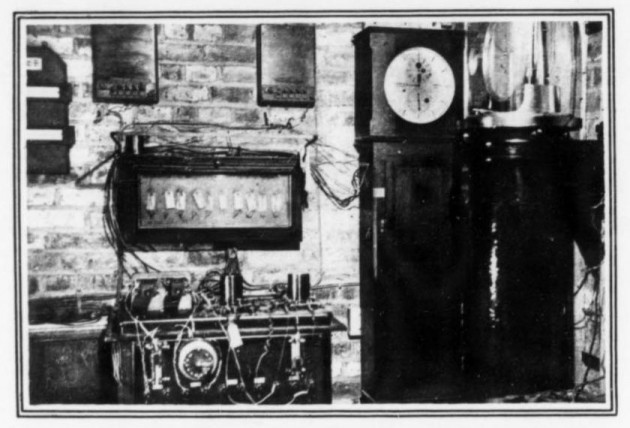
The Cottingham Clock in the Clock Room at Greenwich. Dent 2016, can be seen to its left. Photo by Topical. From the 23 February 1924 edition of The Illustrated London News (via Internet archive)
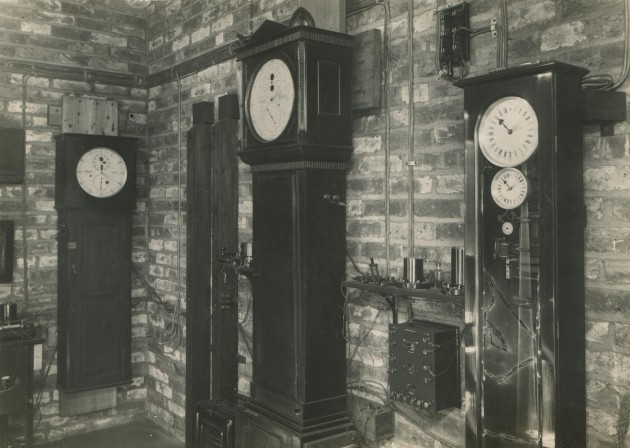
A wider angle view of the Clock Room taken on 7 May 1928. The Cottingham has been dismounted and presumably remounted elsewhere in the room as there is no indication that it was being serviced at this time (RGO39/4/222). From left to right, the three clocks visible are: Dent 2016, Dent 2 and the slave clock of Shortt 11. Humphry Smith photographic archive
Dent 2, whose first definitive appearance in an inventory comes in 1840, had been converted from a mean-time clock to a sidereal one by 1905 and used as a reserve sidereal standard. Soon after the arrival of the Cottingham, Dent 2 was used as a subsidiary clock under its control. In June 1924, Spencer Jones informed the Visitors in his Annual Report (which covered the period up to 30 April), that Dent 2 was under repair. In 1937 he told them it was no longer being used as a subsidiary clock under the control of the Cottingham, but was being renovated and fitted with its original mercurial mean time pendulum and being moved from the Clock Room to the Octagon Room in Flamsteed House. After 1937, there are no further mentions of the Cottingham Clock in the Reports. An inventory of clocks compiled by Roy Tucker in 1954 records the clock as being in Clock Room A at Greenwich – Clock Room A being the new name for the Clock Room in the Meridian Building where the Cottingham was initially installed.
Maintenance records of the Cottingham
The following information is taken from the Observatory’s inventories:
The Cottingham clock was cleaned and overhauled under an order issued on 16 March 1926 (1911 inventory: RGO39/4/61). Another order for overhaul and readjustment was issued on 28 April 1930 (1926 inventory: RG039/5/222). A further order for unspecified work is included in RGO39/5/222 but is undated. There is no record of work on the clock being carried out on the clock in the 1933 inventory (RGO39/6/210).
The testing at Greenwich of other clocks made to Cottingham's design
The Reports of the Astronomer Royal indicate that two clocks of Riefler pattern which were destined for other observatories were tested at the Observatory before being despatched. The following excerpts are taken from the 1924 and 1925 Reports:
1924: ‘A precision clock of Riefler pattern, in air-tight case, and a clock with Graham Escapement, also in an air-tight case, were under test from 1923 February to 1924 March. These clocks, required for the Time Service at Mauritius, were tested at the request of the Crown Agents for the Colonies.’
1925: ‘A precision clock of Riefler pattern, in air-tight case, was under test from 1924 June to 1924 September. This clock, required for the Time Service at Hong Kong, was tested at the request of the Crown Agents for the Colonies. The clock gave a satisfactory performance, and has been despatched for shipment to Hong-Kong.’
It is understood that the clocks were the same as the Cottingham at Greenwich (with modifications?) and that the first was made by Cottingham and the second by Thomas Mercer Ltd., of St. Albans on his behalf under a contract signed on 19 October 1923 (Tony Mercer, 2003). In an obituary written by F. Mercer, the clocks are described as having a simplified Riefler escapement. Further research is required to establish the precise differences between the original Rieflers, the Greenwich Cottingham and the various Mercer versions. According to the obituary written by Eddington, Cottingham made just two Riefler copies in total (Greenwich and Mauritius) and Mercer made three, the one sent to Hong Kong, one which he kept himself and one which was kept by Cottingham and is now at the Science Museum. The dial of the latter carries the names of both Cottingham and Mercer on the dial. Click here for an image of the complete clock (with perspex replacement dome). It would appear however that Mercer also made at least one other copy signed with his name only. Click here to view.
Further reading
The Engineer of Precision Time: Pendulum Clocks by Sigmund Riefler. Bernard Huber (downloads as a pdf). Alternative link
Selected papers by Sampson:
Note on the method of reduction of the Paris wireless rhythmic signals. MNRAS, Vol. 74, p.545 (1914)
The temperature coefficients of the Edinburgh transit circle. MNRAS, Vol. 75, p.69*
On the measurement of, to a thousandth of a second. MNRAS, Vol. 78, p.592 (1918)
Eiffel Tower Wireless Time-Signals. Nature 105, 265 (1920)
Determination of longitude by wireless telegraphy. MNRAS, Vol. 80, p.659 (1920)
On Clock errors and wireless time signals. MNRAS, Vol. 81, p.89 (1920)
On the determination of time at different observatories. MNRAS, Vol. 82, p.215 (1922)
On the cause of anomalous determinations of Time. MNRAS, Vol. 85, p.560 (1925)
Wireless time-signals. Changes in the French issues. MNRAS, Vol. 86, p.82 (1925)
* jointly authored with E.A. Baker
Image licensing
The two photographs of the Riefler 50 in the Rugby Room are © BT Heritage. They have been obtained from The BT Digital Archives and are reproduced under the terms of a Creative Commons Attribution-Non-Commercial-ShareAlike (CC BY-NC-SA) licence issued on 23 July 2013. They have been cropped and are more compressed than the originals. Image TCB 417/E 6036 has also been flipped.
© 2014 – 2025 Graham Dolan
Except where indicated, all text and images are the copyright of Graham Dolan